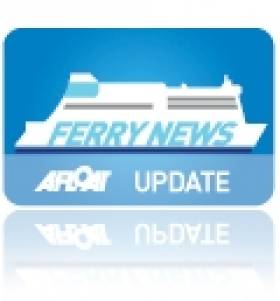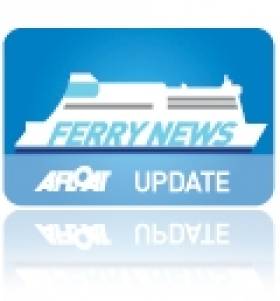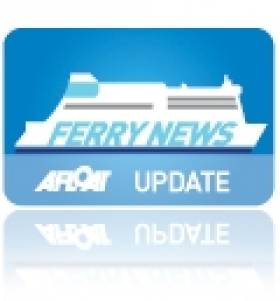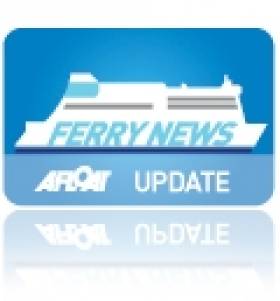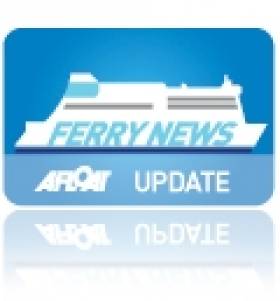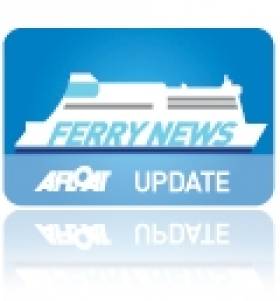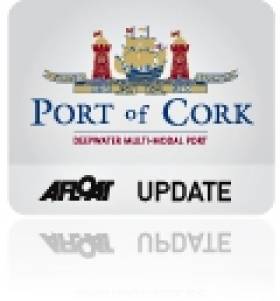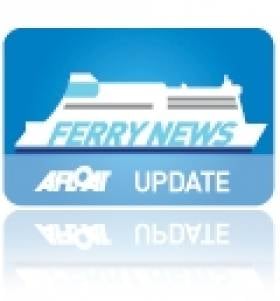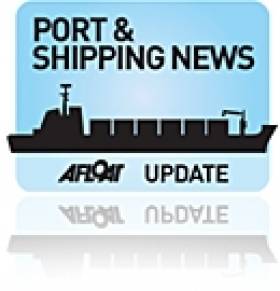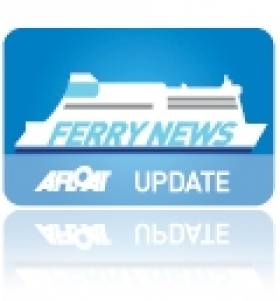Displaying items by tag: Brittany Ferries
Stena Line replaces Former Irish Sea Ferry on Sweden-Poland Route
#BrittanyBaltic – Stena Line are to introduce a larger ro-pax vessel on the Karlskrona-Gdynia route next week with Stena Baltica II, the Brittany Ferries former freight-ferry Cotentin (2007/19,909gt), writes Jehan Ashmore.
The 2,188 lane metre ro-pax Stena Baltica II which as Cotentin ran French-UK-Iberian routes replaces Stena Alegra on the Karlskrona-Gdynia route. The vehicle stern-only loading 'Alegra' of 1,950 lane metres had only began operating in July. She originally entered service as Dawn Merchant in 1999 for Merchant Ferries Dublin-Liverpool service.
Cotentin was built by Aker Finnyards, Helsinki and her return to the Baltic Sea sees the 210 -passenger ro-pax launch the Sweden-Poland route to meet the growing demand for increased freight deck capacity. The 163m long vessel with accommodation for 120 freight-drivers has the ability to load both bow and aft, so-called double tier loading and drive-through on both decks.
Tony Michaelsen, Route Manager Karlskrona-Gdynia said: "We are pleased to have a long-term solution in place that enables us to meet the growing needs of our customers, providing increased flexibility and a greater loading capacity. We have huge demand for capacity on the route and require a third vessel to be able to take care of all the cargo.
Freight volumes between Sweden and Poland have continued to grow. Up to October 2013, freight volumes have increased by 18%, car volumes by 7% and passenger volumes by 9% compared with the same period in 2012.
Michaelsen added, "We expect this trend to continue in the coming years as economic development in Poland and Eastern Europe remains very strong".
Stena Baltica takes over the 'Allegra's schedule by operating three departures a week from Karlskrona and Gdynia. She starts sailings on 24 November with a departure from the Polish port and will operate alongside Stena Vision and Stena Spirit which run regular schedules.
The previous Stena Baltica operated on the same service when the Rosslare-Fishguard ferry Koningin Beatrix was transferred in 2002 to Scandinavia. Her direct replacement Stena Europe currently maintains the St. Georges Channel route. The original 'Baltica' served alongside Stena Nordica which now runs between Dublin Port and Holyhead.
Brittany Ferries 35th Season Ends with Final Sailing
#FerryNews – Brittany Ferries final Cork-Roscoff end of season sailing for 2013 took place on Saturday as the flagship cruiseferry Pont-Aven headed past Cork Harbour's Roches Point Lighthouse, writes Jehan Ashmore.
As previously reported on Afloat.ie, the Irish-French service began operations 35 years ago when Breton based operator Bretagne-Angleterre Irlande (B.A.I) otherwise known as Brittany Ferries introduced the small and sleek Armorique into service in 1978.
Over the decades the French ferry company has continued to grow the service with a range of stylish ferries. The deck interiors exude a typical air of French flair and an extensive art collection of Breton scenes all adding to the holiday atmosphere.
Pont-Aven is a custom-built 41,748 tonnes cruiseferry that features luxury cabins with balconies and there's an indoor swimming pool, the only ferry to have this unique facility serving in Irish waters. The 2,400 passenger /650 cabin cruiseferry returns onto the Irish service in March 2014 on the shortest and fastest route linking the continent with a 14 hour sailing time.
Pont-Aven opens the season with a sailing from Roscoff on 14 March. The following morning she arrives in Cork (Ringaskiddy) ferryport to unload before resuming on her first round-trip leg to Roscoff with a sailing departing in the afternoon.
End of Brittany Ferries Seasonal Sailings
#FerryNews – Brittany Ferries final end of season sailings on the weekend-only operated Cork-Roscoff route is next Saturday (2 November), writes Jehan Ashmore.
The Irish-French route as previously reported was started 35 years ago when the operator Bretagne-Angleterre Irlande (B.A.I) otherwise known as Brittany Ferries introduced the Armorique in 1978.
Current route vessel the custom-built 41,748 tonnes flagship Pont-Aven has been running on the 14-hour service since her launch in 2004.
The 2,400 passenger /650 cabin cruiseferry equipped with a swimming pool returns to the Irish route to start the 2014 season with a sailing from Roscoff on 14 March.
Pont-Aven also serves the Roscoff-Plymouth route in tandem with the Armorique dating from 2008. In addition Pont-Aven runs on the 20.5 hour route from Plymouth to the northern Spainish port of Santander.
Last Chance to Book Brittany Ferries Autumn Getaway
#BrittanyFerries – Brittany Ferries this year celebrate 35 years of Cork-Roscoff service currently served by flagship Pont-Aven, which every weekend makes a round-trip up to early November, writes Jehan Ashmore.
Pont-Aven arrives every Saturday morning and departs in the afternoon bound for Breton port which is a 14 hour crossing.
The luxuriously appointed Pont-Aven has top-class facilities and where French chefs and friendly bi-lingual staff all add to create a typically Gallic and chic atmosphere on board.
Brittany Ferries are offering an early autumn break. Book now and enjoy 6 days in France from €338 return for a car plus two passengers including cabin each way - the equivalent of just €169 per person return.
But hurry...as bookings are to be made by tomorrow (15 September) for travel dates up to 26 October 2013. For further details visit: www.brittanyferries.ie/6-day-late-summer-autumn-getaway
The Irish-French route began operations in 1978 firstly served by the Armorique, followed by Quiberon, Bretagne and Val de Loire.
#BrittanyFerries35th – Today Brittany Ferries celebrates launching into its 35th year in operating the Cork-Roscoff seasonal service served by 'flagship' Pont-Aven, writes Jehan Ashmore.
Speaking about the upcoming 2013 season, General Manager of Brittany Ferries, Mr Hugh Bruton said: "This is always a busy time for us as we re-commence our service from Cork to Roscoff. We are delighted to report that the route is currently ahead by 12% on last year which is a great sign for The Gathering!
"It's also an exciting time for the business as we are celebrating our 40th anniversary globally and 35 years of sailing from Cork to Roscoff. Our continued service offers affordable, convenient holidays to France which is perfect for families of all ages".
Pont-Aven, is not just 'any' ferry as at 41,000 tonnes, she has an array of luxurious facilities to include a spa and swimming pool and an on board ambiance of French flair combined with a bilingual crew.
The flagship departs every Saturday from Ringaskiddy Ferry Terminal until November 2013. She offers the shortest and fastest route between Ireland and France, taking 14 hours, several hours shorter than rivals running routes from Rosslare.
The origins of Brittany Ferries can be directly derived to Breton vegetable farmers who wanted to export their produce to markets in the UK following the closure of other west English Channel ferry routes more than forty years ago.
A co-operative of French farmers got to together to form Bretagne-Angleterre Irlande (B.A.I) otherwise as we know today as Brittany Ferries, which started a new service to Plymouth in 1973.
Brittany Ferries soon found demand not just from agricultural exports but in the reverse direction with passengers from the UK which really boosted the fortunes of the company. On foot of this success and within the next few years further routes were added to include its first route to Ireland opened in 1978.
Armorique, Quiberon, Bretagne and Val de Loire are not just nice-sounding names from locations in Brittany and beyond to conjure images and memories of travels past but these placenames were also given to name the ferries that served the route down through the decades.
The route has also brought closer ties through Irish-Gallic history and heritage but also Celtic cultural connections.
For more information on Brittany Ferries 2013 season schedule and more visit www.brittanyferries.ie
Double Savings Offer with Brittany Ferries
#FrenchFerry- Cork-Rosscoff is the shortest route to France and Brittany Ferries will open the 2013 season in a month's time with sailings served by the luxury cruiseferry Pont-Aven.
Connections to Cork have improved with M7 and M8 motorways, with driving times from Dublin just 2.5 hours and from Belfast taking 4.5 hours.
Brittany Ferries have a range of cottages, apartments and chalet camping in Brittany, Western Loire or beyond.Until the end of the month, savings of 15% can be made on holiday accommodation and 15% on sailings. But hurry, the offer to save twice must book by 28 February.
Sailings begin on 23 March from Ringaskiddy ferryport and operate on Saturdays with an afternoon departure.
For further details on this offer visit: www.brittanyferries.ie/holidays/2013-holiday-offer
Increase in Trade Traffic 2012 Levels for Port of Cork
#PortofCork- A total 9.05 million tonnes was recorded in trade traffic at the end of 2012, according to the Port of Cork Company. This is an increase of 2% compared to 2011 figures and it is the first time traffic figures in the port have surpassed 9 million tonnes since 2008.
2012 was a very challenging year across many sectors including the Irish port sector with the import of goods through Irish ports reported to have fallen by up to 11%. However, the Port of Cork container volumes has shown an increase of 6% with over 165,000 TEU handled during 2012 and imports, excluding oil, are up by 12%. Imports of animal feed stuffs increased by 58% compared to 2011 while fertiliser, cereals and other trades have shown a marginal decrease in 2012.
Oil traffic remained steady despite the lower levels of domestic economic activity; however exports of refined product from Phillips 66 Whitegate Oil Refinery were strong and continue to be a significant part of the Port of Cork business. Exports are a key driver in the successful recovery of the Irish Economy and the Port of Cork is committed to continuous support in the growth of international trade for the country's economic prospects and job creation.
Remarking on the end of year trade traffic results, Mr Brendan Keating, Chief Executive of the Port of Cork said: "The Port of Cork is pleased to announce that our total trade traffic in 2012 remained strong and overall we are starting to see some stabilisation in trade levels in and out of the Port. With 98% of volume of all goods imported or exported from Ireland moved by ship, the importance of ports to our economy is of vital strategic importance. We will continue to look to the sectors that are performing strongly, such as food exports and will seek to capitalise on the demand for such goods from Europe and emerging markets."
He continued: "The Port of Cork is a key link to the continued economic success of Ireland and in particular the entire Munster region. The challenge now facing us in 2013 is to continue to develop the Port in order to meet the needs of the Country as it emerges from this current recession. We will continue to be extremely active in the emerging trends and logistic supply changes to reinforce our existing strength as the primary deepwater port in the south of Ireland and build on our progress to date".
Port officials are pro-actively engaged with tourism interests, County and City Councils and destination attractions to enhance the product on offer to the visiting cruise lines with a view to growing the business further through its dedicated cruise terminal. 57 cruise vessels visited the Port of Cork during 2012 bringing almost 100,000 passengers and crew to the region and the Port is scheduled to accommodate 64 vessels in 2013.
The Port of Cork was awarded two Cruise Insight Awards for 'Best Shore Side Welcome' and 'Best Tour Guides' which were announced at the global shipping conference, Seatrade Miami in April 2012. This achievement highlighted the outstanding team effort and commitment by the Port of Cork to deliver an excellent service to the visiting cruise lines and their passengers when in Cork.
The Port is delighted to be supporting The Gathering for 2013 and is actively ensuring that all visitors who transit through our facilities receive a warm welcome to Irish shores. Brittany Ferries remained steady on its weekly ferry service from Cork to Roscoff and the Port remains fully committed to establishing new routes and services from Cork.
The Port of Cork's recreational strategy continues to expand with the aim of improving the marine leisure facilities around Cork Harbour.
End of Season Sailing for Brittany Ferries
#FERRY NEWS- The final Brittany Ferries sailing for 2012 departs on the return leg of the Cork-Roscoff route next Saturday 3 November, writes Jehan Ashmore.
Those intending to book on the 14-hour route, only operated on weekends, should consult the ferry company's website for sailing times and prices.
Brittany Ferries have operated the route to France since 1978, first served by the Armorique. Currently the service is served by flagship Pont-Aven. The German built cruiseferry also maintains crossings on a triangular route network between France and the UK and also UK-Spain.
Next year's season opens with a sailing departing Roscoff on 22 March 2013 and with a return sailing to the Breton port from Cork's Ringaskiddy ferry terminal on 23 March.
Ports & Shipping Review: EU Ports Conference, Irish Cargoship Strikes Rock, Cruise Sector, Lifeline for WWI Warship, Lightship Scrapped and more…
#PORTS & SHIPPING REVIEW - Over the last fortnight Jehan Ashmore has reported from the shipping scene, where the European Commission hosted a major ports conference on the EU policy framework for ports.
Irish Ferries won 'Best Ferry Operator' in an award held in Birmingham, which was presented by Group Leisure, a leading British travel trade publication.
A brand new Irish flagged cargoship, Huelin Dispatch (2012/2,545grt) struck a rock while on its maiden voyage from Southampton to the Channel Islands. No crew were injured and the vessel was re-floated and then proceeded to dry-dock in Falmouth.
Large cruiseship operators could be a source of funding for the proposed redevelopment of Galway Port, a Joint Oireachtas Committee on Transport and Communications has been told.
Next year cruise passengers will be able for the first time to travel directly from Ireland to Norway on a major cruiseship from Cobh operated by Royal Caribbean International.
The 98 year-old HMS Caroline, berthed in Belfast, is to be given a lifeline, after the Stormont Assembly is to allocate £100,000 for restoration work on the famous World War I warship.
An industrial dispute over crew salaries and conditions at Brittany Ferries which ran for ten days ended earlier this week and where sailings on the Cork-Roscoff route returned to service yesterday.
The former headquarters of the Commissioners for Irish Lights in Dublin 2 is for sale at €2.85 million on the instructions of Nama, which is 89% drop on the €26 m paid for the block in 2006 by Pembroke Partnership.
A report by the MCIB was published into the grounding of Arklow Raider (2007/2,999grt) at the mouth of the River Boyne in 2010, nobody was injured and no pollution occurred.
One of the last surviving Irish lightships, ALF Skua which was automated in the early 1980's, finally ended her days as work on scrapping took place on the banks of the River Avoca in Arklow.
Today marks the final day of the Open House Dublin weekend, which was organised is to make architecture more accessible to the public and free of charge. Among the events today are guided tours (first come, first served basis) of the current headquarters of the Commissioners of Irish Lights and the National Maritime Museum of Ireland also located in Dun Laoghaire. For details visit www.openhousedublin.com
Brittany Ferries Sailings Resume Service
#FERRY NEWS- Brittany Ferries are to resume sailings today, following the end of an industrial dispute as previously reported on Afloat.ie, which was carried out by employees that led to services halted between UK, France, Ireland and Spain.
The Breton ferry company was forced to suspend services for 10 days after strikes erupted and employees fought to disrupt the operator which sought cuts in costs by reducing salaries and the frequency of crossings.
The Irish service, operated by the Pont-Aven on the weekend only round-trip route from Roscoff to Cork, is to depart the French port this Friday 5th October, at 21.15hrs. The return sailing departs Cork (Ringaskiddy) on Saturday 6th October at 16.00hrs.
All English Channel routes are to resume today though the company had to cancel tomorrow's 11.00hrs sailing from Portsmouth to Santander as the ship is out of position.



























